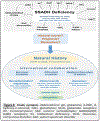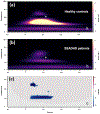Succinic Semialdehyde Dehydrogenase Deficiency: Review of the Natural History Study
- PMID: 33393837
- PMCID: PMC8254814
- DOI: 10.1177/0883073820981262
Succinic Semialdehyde Dehydrogenase Deficiency: Review of the Natural History Study
Abstract
Objective: The SSADHD Natural History Study was initiated in 2019 to define the natural course and identify biomarkers correlating with severity.
Methods: The study is conducted by 4 institutions: BCH (US clinical), WSU (bioanalytical core), USF (biostatistical core), and Heidelberg (iNTD), with support from the family advocacy group (SSADH Association). Recruitment goals were to study 20 patients on-site at BCH, 10 with iNTD, and 25 as a standard-of care cohort.
Results: At this half-way point of this longitudinal study, 28 subjects have been recruited (57% female, mean 9 years, range 18 months-40 years). Epilepsy is present in half and increases in incidence and severity, as do psychiatric symptoms, in adolescence and adulthood. The average Full Scale IQ (FSIQ) was 53 (Verbal score of 56, Non Verbal score of 49), and half scored as having ASD. Although there was no correlation between gene variant and phenotypic severity, there were extreme cases of lowest functioning in one individual and highest in another that may have genotype-phenotype correlation. The most common EEG finding was mild background slowing with rare epileptiform activity, whereas high-density EEG and magnetoencephalography showed reduction in the gamma frequency band consistent with GABAergic dysfunction. MR spectroscopy showed elevations in the GABA/NAA ratio in all regions studied with no crossover between subjects and controls.
Conclusions: The SSADH Natural History Study is providing a unique opportunity to study the complex pathophysiology longitudinally and derive electrophysiologic, neuroimaging, and laboratory data for correlation and to serve as biomarkers for clinical trials and prognostic assessments in this ultra-rare inherited disorder of GABA metabolism.
Keywords: epilepsy; genetics; inborn errors of metabolism; intellectual disability; metabolism; neuroimaging.
Conflict of interest statement
Disclosure of conflict of interests:
Phillip Pearl is supported in part by a grant from PTC Therapeutics.
Melissa DiBacco is supported in part by a grant from PTC Therapeutics.
Christos Papadelis reports no disclosures or conflicts of interest.
Thomas Opladen reports no disclosures or conflicts of interest.
Jean-Baptiste Roullet reports no disclosures or conflicts of interest.
Michael Gibson reports no disclosures or conflicts of interest.
Figures






References
-
- Pearl PL, Novotny EJ, Acosta MT, Jakobs C, Gibson KM. Succinic semialdehyde dehydrogenase deficiency in children and adults. Ann. Neurol, 2003; 54 (Suppl. 6):S73–S80. - PubMed
-
- Gibson KM, Gupta M, Pearl PL, et al. Significant behavioral disturbances in succinic semialdehyde dehydrogenase (SSADH) deficiency (gamma-hydroxybutyric aciduria). Biol. Psychiatry, 2003;54:763–768. - PubMed
-
- Pearl PL, Gibson KM, Acosta MT, Vezina LG, Theodore WH, Rogawski MA, Novotny EJ, Gropman A, Conry JA, Berry GT, Tuchman M. Clinical spectrum of succinic semialdehyde dehydrogenase deficiency. Neurology. 2003. May 13;60(9):1413–7. - PubMed
-
- Zeiger WA, Sun LR, Boseman T, Pearl PL, Stafstrom CE. Acute Infantile Encephalopathy as Presentation of SSADHD. Pediatr Neurol, 2016; 58:113–5. - PubMed
Publication types
MeSH terms
Substances
Supplementary concepts
Grants and funding
LinkOut - more resources
Full Text Sources
Other Literature Sources
Medical

